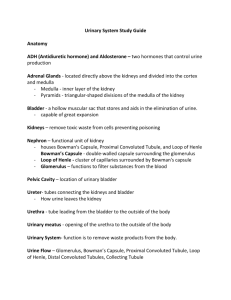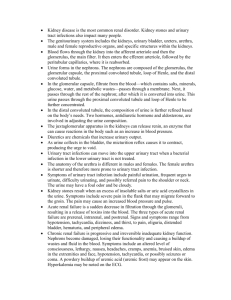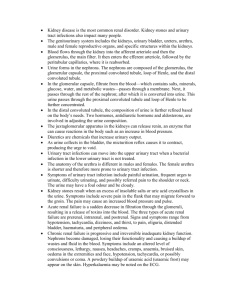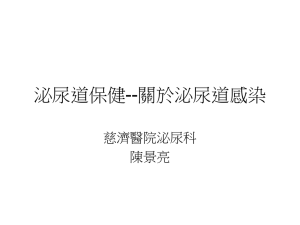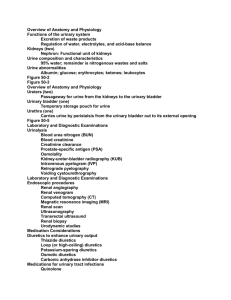The Urinary System Anatomy and Physiology (rev. 3/11) Structure
advertisement
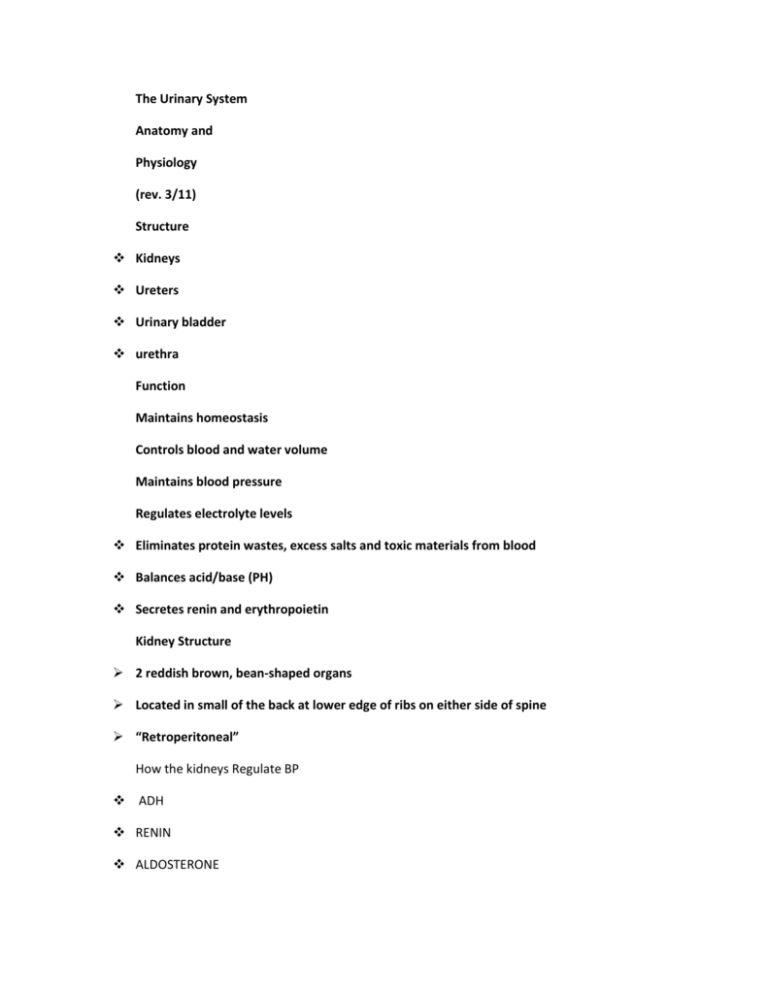
The Urinary System Anatomy and Physiology (rev. 3/11) Structure Kidneys Ureters Urinary bladder urethra Function Maintains homeostasis Controls blood and water volume Maintains blood pressure Regulates electrolyte levels Eliminates protein wastes, excess salts and toxic materials from blood Balances acid/base (PH) Secretes renin and erythropoietin Kidney Structure 2 reddish brown, bean-shaped organs Located in small of the back at lower edge of ribs on either side of spine “Retroperitoneal” How the kidneys Regulate BP ADH RENIN ALDOSTERONE 3 Parts Cortex Medulla Pelvis Nephron Functional units of the kidney Cells that form urine Over 1 million nephrons in each kidney Definitions 1. Oliguria 2. Anuria 3. Dysuria 4. Polyuria 5. hematuria Urine Body excretes 1000-1500 ml of urine/day Is normally sterile Color varies with hydration Characteristics of Normal Urine CLARITY ODOR SPECIFIC GRAVITY THINK…. A STRONG, OFFENSIVE ODOR FROM FRESHLY VOIDED URINE IS SUGGESTIVE OF…….. Urinary Tract Infection Composition of Normal Urine Water Protein wastes products (urea, uric acid & creatinine) Excessive minerals from diet (Na+,K+, Ca,sulfates & phosphates Toxins Hormones Bile compounds Pigments from food/drugs Commom GU Terms Frequency Urgency Nocturia Enuresis retention Effects of Aging on the Urinary System Ability to filter blood, reabsorb electrolytes & secrete wastes decreases Less ability to return to normal after changes in blood volume Decrease in number & size of nephrons Decrease in GFR Smaller capacity of bladder Weaker bladder muscles Incontinence Not a normal consequence of age Common due to many reasons See Chpter 23 for more information Nursing Assessment of The Urinary System HEALTH HISTORY Chief complaint History of Present Illness Past Medical History Family History Review of Systems Diagnostic & Laboratory Tests Urinary System URINE TESTS UA ( urinalysis ) C & S ( Culture & Sensitivity ) Creatinine Clearance (24 hr) BLOOD TESTS BUN ( blood urea nitrogen ) Serum Creatinine Serum Electrolytes Radiographic Studies KUB ( flat plate ) IVP Arteriogram Renal Scan US Invasive Procedures 1. Renal Biopsy 2. Cystoscopy What are Urodynamic Studies ?? What are common Therapeutic measures Related to “Catheterization” Common Tubes and Catheters Ureteral Catheter Nephrostomy Tube Urinary Stent Renal Disease Unavoidable if disease processes exist in other systems Obstructive Disorders Urolithiasis Calculus or stone formed in the urinary tract Etiology is unknown Can occur in renal pelvis, ureters, bladder or urethra Contributing Factors Infection & or Dehydration Urinary stasis Immobility Recurrent UTI’s Diet rich in calcium Signs & Symptoms Size & location of stone affects degree of pain “colic” hematuria Nursing Considerations Strain all urine & pain relief Send gravel or stones to lab Monitor of s/s infection Give antispasmodics Encourage fluids ; IV Manage Pain Pharmacological Bromide (Pro-Banthine) Antibiotics Zyloprim Calcibind Surgical Management Lithotripsy (ESWL) Urethroscopy Nephrolithotomy Ureterolithotomy Nephrolithiasis Calculi in the kidney Percutaneous Nephrolithotomy Hydronephrosis Distention of kidney Can cause permanent damage Maintain accurate I & O Strain all urine Send all stones for analysis Infectious Diseases Of the Urinary Tract Cystitis Inflammation of the urinary bladder Bacteria enters from the urethra, lymph nodes, infected kidneys Women more suseptible Causes E-coli Candida Albicans Coitus Prostatitis Diabetes mellitus Signs & Symptoms Dysuria Frequency Burning Hematuria Chills, fever Nursing Considerations C&S and UA obtained Increase fluids Antibiotics (Cipro,Bactrim,Septra Analgesics(Pyridium) Gerontologic Considerations Watch for signs of mental confusion Fever may be masked Sepsis develops quickly Pyelonephritis Bacterial infection of renal pelvis and kidney Most common form of kidney disease Often the result of reflux Bacteria ascend from bladder, up through ureter & into kidney Obstruction in ureter Pyelonephritis : May be acute or chronic If chronic, may cause high BP &/or chronic renal failure Signs & Symptoms Flank pain Pyuria Chills, fever,N & V dysuria Bacteruruia w/ WBC’s Nursing Considerations Bedrest Increase fluids IV Monitor I + O Daily weights Pharmacological TX Sulfonamides (Bactrim) or Cipro Antipyretics Analgesics Glomerulonephritis Autoimmune disease Glomerulus becomes inflammed Symptoms dev. 1-3 wks after respiratory infection cau by group A- hemolytic strep Acute Symptoms may go unnoticed at first Puffy face Edema Mild to severe HTN Tea colored urine Hematuria Severe headaches Irritability Hypervolemia Nursing Considerations Bedrest several weeks Strict I & O, daily weights Restrict Fluids if ordered Low Na, low protein diet Prognosis is good UA w/ RBC’s, Albumin, casts protein Pharmacological TX Penicillin Diuretics (Lasix) Antihypertensive medications Chronic Much more serious than acute May permanently damage the kidney by destroying nephrons Signs & Symptoms Disease flares up at intervals General malaise Albumin in urine Pale/dilute urine Hypertension w/ headaches Marked edema Treatment Low Na, protein diet Bedrest VS, BP… Strict I & O Restrict fluids Condition may lead to pulmonary edema, increased BP,anemia,cerebral hemorrage, CHF and ultimately uremia or ESRD In the absence of dialysis or kidney transplant, prognosis is poor. Polycystic Kidney Disease Congenital, familial, also may be acquired Fluid-filled cysts Abdominal, low back or flank pain and headache Diagnosis X-ray or sonogram BUN & Creatinine Goal of management is….. Renal Failure A.K.A. Uremia May be Acute or Chronic Renal Failure Kidneys no longer meet everyday demands Kidneys unable to filter waste products from blood BUN & Creatinine levels elevate Causes of Renal Failure Glomerulonephritis IDDM Any condition which decreases blood supply to kidneys Injury Recurrent UTI Drug overdose Poisoning Nephrotoxic Drugs Acute Renal Failure CAUSED BY: 1. Prerenal Failure 2. Intrarenal Failure 3. Postrenal Failure Acute Renal Failure 4 PHASES 1.Onset 2.Oliguria 3.Diuresis 4.Recovery Medical & Drug Management Antihypertensives Diuretics Cardiotonics Dialysis if needed Diet & Fluids Diet based on consideration of serum electrolytes and BUN. Adequate carbs to prevent breakdown of fat & protein. Fluids calculated by adding 600ml to previous days output. Nursing Considerations Freq. BUN, Creatinine, Na & K levels Usually Low Na, K and protein diet Mon. I & O Chronic Renal Failure “ESRD” Irreversible Chronic abnormalities in internal environment of kidney Dialysis or kidney transplant necessary for survival Signs & Symptoms • Azotemia • Hyperkalemia • Hypocalcemia • Metabolic acidosis • Hypernatremia and hypervolemia • Insulin Resistance Medical Treatment IV Glucose and Insulin Calcium, Vitamin D and phosphates Fluid restriction & diuretics Beta blockers, calcium channel blockers and ACE inhibitors Iron, folic acid and synthetic erythropoietin High carb/low protein diet Dialysis • Mechanical • Imitates the function of the nephron • May be chronic or acute • Removes body wastes through semipermeable membrane Dialysis Peritoneal Hemodialysis Hemodialysis Blood circulates through a machine outside the body Semipermeable membrane is within machine “Artificial kidney” Performed 3x/wk for approx. 4 hrs AV Shunts, fistula or cannula All allow access to the arterial system All must be assessed for patency by: “Feel the thrill” & “listen for the bruit” Peritoneal Dialysis Uses the peritoneal lining of the abd. Cavity as semipermeable membrane Diffusion & osmosis occur through membrane Performed 4x/day 7 days/wk 3 Phases of Peritoneal Dialysis Inflow Dwell Drain All 3 phases comprise one exchange CAPD • Used in the home • Freedom from machines • Steady bld chemistry levels • Process is shorter • Less expensive CCPD Also called: Automated peritoneal dialysis Requires a cycler Free from exchanges during day Must take cycler if traveling Nursing Considerations Weigh before & after VS Observe for edema, resp. distress Check bleeding at access site Acc. I & O, ? Fluid restriction High calorie Low protein, Na & K diet Strict asepsis Skin care ( s/s infection) Kidney Transplant Kidney Donation Live donor or cadaver Tissue and blood-typed Amendment to Social Security Act Why is counseling advised for both donor and recipient? Before surgery… BP medications Immunosuppressant drugs Possible transfusion Dialyzed before transplantation Explore patient understanding Record VS Address questions Surgery & Complications See fig. 40-16 pg. 879 ATN, rejection, renal artery stenosis, hematomas, abscesses and leakage of ureteral or vascular anastomoses Organ Rejection Hyperacute Acute Chronic s/s fever, ^ BP, pain at site of new kidney Immunosuppressant drugs Why are they called: Immunosuppressants???? What is the patient predisposed to??? Routine Nursing Care Monitor urine output Monitor fluid intake VS Note weight changes TC & DB Control pain Bladder CA Most common site of urinary system CA Men bet. 50-70 yrs Most bladder tumors are malignant Risk Factors Cigarette smoking Lung cancer Caffeine intake Dyes found in industrial compounds Medical Treatment Cytoscopic resection Fulguration Laser photocoagulation Segmental resection Radical cystectomy Types of urinary Diversion Ileal conduit (most common) Sigmoid conduit Ureterostomy Nephrostomy Continent internal ileal reservoir (Kock pouch) Nursing Interventions • VS • I&O • Patency of tubes • BS, stoma appearance • Special skin care • Signs of infection Catheter Types Foley Ureteral Suprapubic Nephrostomy 1.Foley Catheter -into bladder -balloon 2.Ureteral Catheter -surgical incision through back 3.Suprapubic Catheter -incision into low abdomen -directly into bladder 4.Nephrostomy Catheter -incision directly into renal pelvis through back


